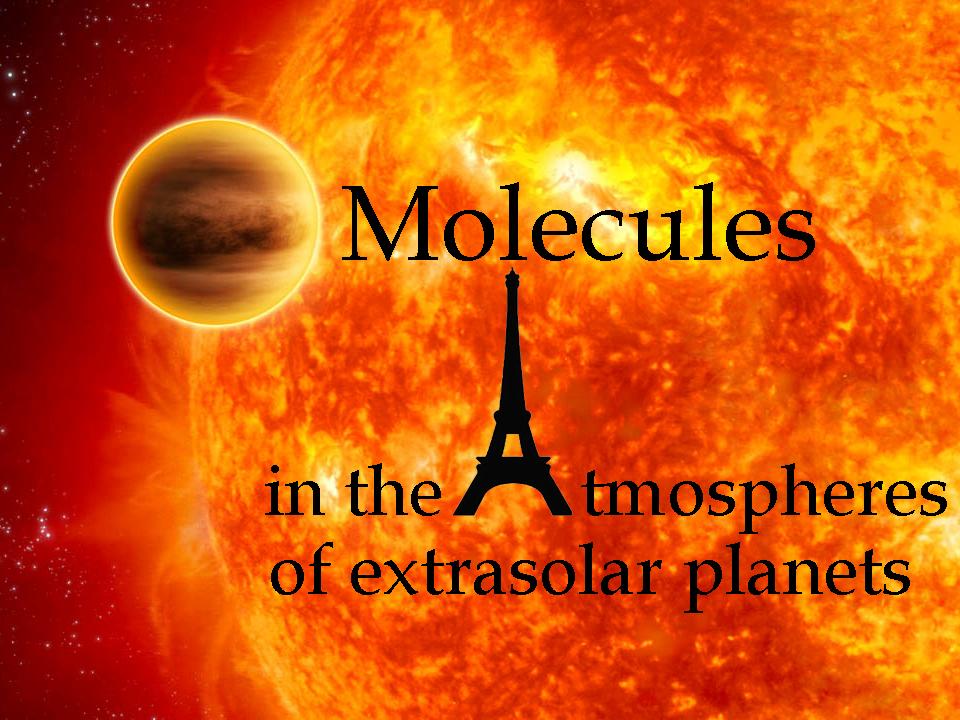

Scientific program
Observatoire de Paris, Salle Cassini November 19-20-21, 2008
With the ppt or pdf files, and movies !
Wednesday November 19th
Registration opens at 8:00.
Ouverture :
0845-0900 : D. EGRET Welcome to Obs de Paris
0900-0930 : SCHNEIDER Molecules in exoplanets: beyond the standard view
1a) Exoplanet atmospheres from transit observations (Chair :
TINETTI)
09:30-10:00 : CHARBONNEAU, review + The Small Star Opportunity to Explore
Super-Earth Atmospheres
10:00-10:30 : HARRINGTON, review on secondary transit + new results
10:30-11:00 : SWAIN, Methane Detected in an Extrasolar Planet Atmosphere
(emphasis on spectroscopy)
--coffee break 11:00-11:40---
11:40-12:10 : VASISHT, Infrared Spectrophotometry of Exoplanets with the
Hubble Space Telescope
12:10-12:40 : KNUTSON, Temperature Inversions in the Atmospheres of Hot
Jupiters: Origins, Characteristics, Consequences.
1b) Exoplanet atmosphere dynamics (Chair : TERQUEM)
12:40-13:10 : SHOWMAN, Atmospheric circulation of hot Jupiters
-------lunch break-------
14:15-14:45 : CHO, Some crucial aspects of atmospheric dynamics
for circulation and characterization
14:45-15:05 : AYLWARD, Introduction to thermosphere and exosphere of
extrasolar planets
1c) Contributed talks, exoplanet atmosphere dynamics (Chair
: SHOWMAN)
15:05-15:25 : IRO, atmosphere of extrasolar planets on eccentric
orbits
15:25-15:45 : LEWIS, Atmospheric Dynamics of Two Eccentric
Transiting Planets: GJ436b and HD 17156b
15:45-16:05 : KOSKINEN, A 3D Model for the Upper Atmosphere and
Ionosphere of Extrasolar Giant Planets
-----tea break---- 16:05-16:35-----
1d) Contributed talks, transit observations (Chair :
VASISHT)
16:35-16:55 : BENDER, Direct spectroscopic characterization of
non-transiting exoplanets
16:55-17:15 : BARNES, Detecting H_2O and CO in the atmospheres of close
orbiting extrasolar giant planets using high resolution spectroscopy
17:15-17:35 : SNELLEN, Groundbased detection of Sodium in the
transmission spectrum of HD 209458b
17:35-17:55 : CARTER, NICMOS spectrophotometric observations of HD
149026b
17:55-18:15 : KIPPING, exomoons
18h25-18:45 : Poster Speed Session
Thursday November
20th
1d) Contributed talks, transit observations (Chair :
VASISHT)
08:15-08:35 : ANDERSON, WASP planets and their characterisation
08:35-08:55 : DESERT, Space-based search for molecules in exoplanetary
atmospheres.
08:55-09:15 : SING, HST/Nicmos narrow band photometry of HD 189733b
2b) Planets in the Solar System: overview (Chair :
COUSTENIS)
09:15-09:55 : LELLOUCH, The composition of planetary atmospheres: a
historical perspective
09:55-10:35 : YUNG, Photochemistry in the Atmosphere of Exoplanets
10:35-11:05 : CHASSEFIERE, upper atmosphere of Venus, Earth, Mars
-----coffee break--- 11:05-11:35-------
11:35-12:05 : MAILLARD, Observations of H3+ in emission in planetary
atmospheres
12:05-12:35 : MILLER, The role of H3+ in planetary atmospheres
(movie 1)
(movie 2)
12:35-12:55 : HOCHLAF, Ionic Chemistry in Titan: C2N2++ dication
formation and fragmentation
12:55-13:15 : LEACH, VUV spectroscopy and photophysics of prebiotic molecules
-------- afternoon-------
2c) Molecular data-lists (Chair : BEZARD)
14:15-14:55 : ROTHMAN, Spectroscopic Parameters for the Atmospheres of
Extrasolar Planets
14:55-15:15 : (Miller/Aylward for Tennyson), Molecular linelists for
extrasolar planets
15:15-15:35 : ROUEFF, Visible-Optical to near InfraRed (VOIR) Emission
of electron excited H2
Special session (Chair : BEAULIEU)
15:35-15:55 : CLAMPIN, Optical images of an exosolar planet 25 light
years from Earth
15:55-16:15 : DOYON, Direct imaging of Multiple planets orbiting HR8799
-------tea break ------16:15-16:35----
2d) Brown dwarfs (Chair : MAILLARD)
16:35-17:15 : BURGASSER, The Brown Dwarf-Exoplanet Connection and (for MARLEY) The Importance of Non-equilibrium Chemistry: Lessons for Exoplanets from Brown Dwarfs
17:15-17:35 : ALLARD F., Cloud formation in the atmospheres of Brown
Dwarfs and Giant Planets
(movie)
17:35-17:55 : MENARD, Linear Polarisation of ultra cool dwarfs
19:30-23:00 : Reception with dinner cocktail, and wine tasting.
Friday November 21th
08:10-08:30 : HOMEIER, Mixing and CE departures in ultracool atmospheres
08:30-08:50 :
FREYTAG, Radiation hydrodynamics simulations of dust
clouds
3b) Terrestrial exoplanets (modelling, habitability, detection of
biosignatures) (Chair : RIBAS)
08:50-09:10 : COUDE' DU FORESTO, The Blue Dot Team: pathways to
habitable planets
09:10-09:30 : LAHAV, ExoFit: Orbital Parameters of Extra-solar
Planets from radial velocities
09:30-09:50 : SELSIS, Characterizing habitable planets around
M stars with the JWST
09:50-10:20 : STAM, Polarimetry of Exoplanets in Theory and in
Practise
10:20-10:40 : PALLE, The transmission spectra of planet Earth
10:40-11:10 : TRAUB, Transit Spectra of Super-Earths
----coffee break ----11:10-11:40
11:40-12:00 : LAMMER, The loss of N2-rich atmospheres from Earth-like
planets within M-star habitable zones
12:00-12:20 : GRENFELL, SIMULATING BIOSIGNATURES FROM TERRESTRIAL
PLANETS
12:20-12:40 : HEDELT, Characterization of atmospheres of extrasolar
terrestrial planets: Predictions of spectral appearance
3c) The future: short and long term missions and instruments to
characterise exoplanet atmospheres. (Chair : COUDE DU
FORESTO)
12:40-13:10 : BOCCALETTI, A review of direct detection programs
13:10-13:30 : SWINYARD, SPICA
Afternoon 14:15
----
14:15-14:45 : CASH, High Quality Spectroscopy of Exoplanets Using the
New Worlds Observer
14:45-15:05 : CLAMPIN, Capabilities of the James Webb Space Telescope
for Transit Observations
15:05-15:35 : SERABYN, interfero/corono from the ground
15:35-16:05 : ENYA, SPICA for the exo-planet observation (coronograph)
-----tea break---16:05-16:35
16:35-17:05 : BEUZIT, EPICS & SPHERE
17:05-17:35 : OLLIVIER, Spectral analysis of atmospheres by nulling
interferometry
17:35-1755 : DOYON Detecting and Characterizing Exoplanets with the
JWST Tunable Filter Imager
17:55-18:25 : BAUDOZ, SEE-Coast
3d) General discussion and conclusions.
FREEDMAN & SCHWENKE : Spectrum and opacity of CO2. Comparison of available databases.